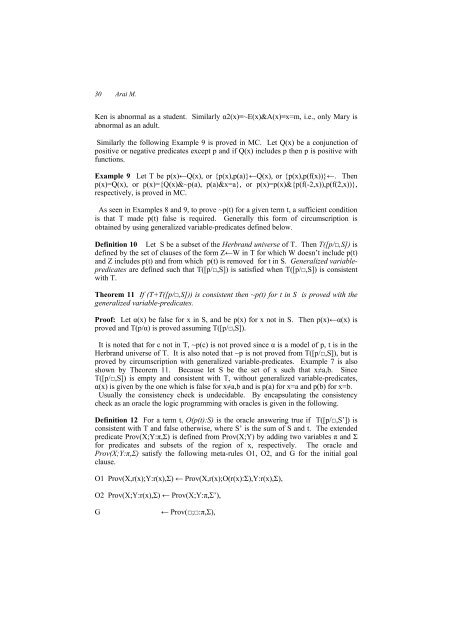Advances in Artificial Intelligence Theory - MICAI - Mexican ...
Advances in Artificial Intelligence Theory - MICAI - Mexican ...
Advances in Artificial Intelligence Theory - MICAI - Mexican ...
You also want an ePaper? Increase the reach of your titles
YUMPU automatically turns print PDFs into web optimized ePapers that Google loves.
Ken is abnormal as a student. Similarly α2(x)≡~E(x)&A(x)≡x=m, i.e., only Mary is<br />
abnormal as an adult.<br />
Similarly the follow<strong>in</strong>g Example 9 is proved <strong>in</strong> MC. Let Q(x) be a conjunction of<br />
positive or negative predicates except p and if Q(x) <strong>in</strong>cludes p then p is positive with<br />
functions.<br />
Example 9 Let T be p(x)←Q(x), or {p(x),p(a)}←Q(x), or {p(x),p(f(x))}←. Then<br />
p(x)=Q(x), or p(x)={Q(x)&~p(a), p(a)&x=a}, or p(x)=p(x)&{p(f(-2,x)),p(f(2,x))},<br />
respectively, is proved <strong>in</strong> MC.<br />
As seen <strong>in</strong> Examples 8 and 9, to prove ~p(t) for a given term t, a sufficient condition<br />
is that T made p(t) false is required. Generally this form of circumscription is<br />
obta<strong>in</strong>ed by us<strong>in</strong>g generalized variable-predicates def<strong>in</strong>ed below.<br />
Def<strong>in</strong>ition 10 Let S be a subset of the Herbrand universe of T. Then T([p/□,S]) is<br />
def<strong>in</strong>ed by the set of clauses of the form Z←W <strong>in</strong> T for which W doesn’t <strong>in</strong>clude p(t)<br />
and Z <strong>in</strong>cludes p(t) and from which p(t) is removed for t <strong>in</strong> S. Generalized variablepredicates<br />
are def<strong>in</strong>ed such that T([p/□,S]) is satisfied when T([p/□,S]) is consistent<br />
with T.<br />
Theorem 11 If (T+T([p/□,S])) is consistent then ~p(t) for t <strong>in</strong> S is proved with the<br />
generalized variable-predicates.<br />
Proof: Let α(x) be false for x <strong>in</strong> S, and be p(x) for x not <strong>in</strong> S. Then p(x)←α(x) is<br />
proved and T(p/α) is proved assum<strong>in</strong>g T([p/□,S]).<br />
It is noted that for c not <strong>in</strong> T, ~p(c) is not proved s<strong>in</strong>ce α is a model of p, t is <strong>in</strong> the<br />
Herbrand universe of T. It is also noted that ~p is not proved from T([p/□,S]), but is<br />
proved by circumscription with generalized variable-predicates. Example 7 is also<br />
shown by Theorem 11. Because let S be the set of x such that x≠a,b. S<strong>in</strong>ce<br />
T([p/□,S]) is empty and consistent with T, without generalized variable-predicates,<br />
α(x) is given by the one which is false for x≠a,b and is p(a) for x=a and p(b) for x=b.<br />
Usually the consistency check is undecidable. By encapsulat<strong>in</strong>g the consistency<br />
check as an oracle the logic programm<strong>in</strong>g with oracles is given <strong>in</strong> the follow<strong>in</strong>g.<br />
Def<strong>in</strong>ition 12 For a term t, O(p(t):S) is the oracle answer<strong>in</strong>g true if T([p/□,S’]) is<br />
consistent with T and false otherwise, where S’ is the sum of S and t. The extended<br />
predicate Prov(X;Y:π,Σ) is def<strong>in</strong>ed from Prov(X;Y) by add<strong>in</strong>g two variables π and Σ<br />
for predicates and subsets of the region of x, respectively. The oracle and<br />
Prov(X;Y:π,Σ) satisfy the follow<strong>in</strong>g meta-rules O1, O2, and G for the <strong>in</strong>itial goal<br />
clause.<br />
O1 Prov(X,r(x);Y:r(x),Σ) ← Prov(X,r(x);O(r(x):Σ),Y:r(x),Σ),<br />
O2 Prov(X;Y:r(x),Σ) ← Prov(X;Y:π,Σ’),<br />
G<br />
← Prov(□;□:π,Σ),

















